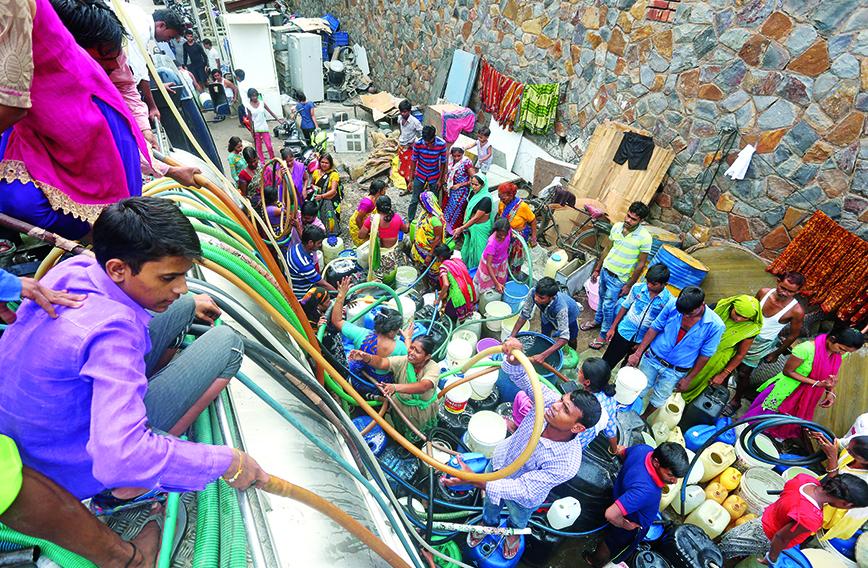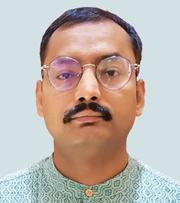

VENKATESH DUTTA
MOST of the water consumed in Delhi is not of its own. Delhi’s water reflects a strange mix of power, politics and money. The national capital is heavily dependent on external water sources to meet its ever-rising demand. At present, Delhi is grappling with a deficit of about 400 million gallons per day (MGD) of water in meeting its total estimated demand of 1,380 MGD. The national capital gets its water from the Yamuna, Ganga and Sutlej rivers.
To transport water from these rivers, an extensive system of canals, dams, reservoirs and pipe networks has been built. The cost of infrastructure including storage and the energy cost of pumping is huge, running into thousands of crores of rupees every year. This does not include the environmental cost of water transfer from these rivers — depriving these rivers of their ecological flows and the potential impact in terms of increasing disaster risks.
After flowing for around 400 km the Yamuna meanders through Delhi’s eastern segment, flowing 54 km from Palla to Badarpur. The quantity of water is not always dependable and fluctuates throughout the year. There is no problem during the three monsoon months from July to September.
However, the water levels decline markedly during the summer months, from April to June. This decline is attributed to the sharp rise in demand for Yamuna water by other states, including Delhi, pursuant to a water-sharing agreement. Delhi’s reliance on external surface water sources is primarily driven by the perennial issue of low water levels for the majority of the year in the Yamuna within the city’s boundaries. This chronic problem is further aggravated by the substantial influx of untreated wastewater from two dozen drains and the subpar quality of the available water.
The first external water source is the Upper Ganga Canal (UGC), which originates from the Ganga in Haridwar. The UGC supplies over a quarter (26.3 percent) of Delhi’s daily raw water requirement. This canal was built during British times primarily for irrigating the western regions of Uttar Pradesh. Now it serves as a vital source for meeting the drinking water requirement of a large population. The canal comes closest to Delhi’s eastern border at Muradnagar in UP, where infrastructure has been developed to transport canal water into Delhi.
This water undergoes treatment at Sonia Vihar and the Bhagirathi water treatment plants and is subsequently distributed to the southern, eastern, and northeastern parts of Delhi. Before the winter starts, the UP Irrigation Department temporarily closes the canal for routine maintenance, which includes clearing silt from the canal. This temporary closure inevitably results in a disruption of water supply to Delhi.
The second external water source comprises two separate canals—the Western Yamuna Canal (WYC) and the Munak Canal coming from the neighbouring state of Haryana. The WYC commences at the Hathnikund barrage in Yamuna Nagar district of Haryana, drawing its water from the Yamuna river. The Hathnikund barrage was constructed between 1996 and 1999. It replaced the older Tajewala barrage three km downstream which was constructed in 1873.
The Munak Canal, a 102-km aqueduct also referred to as the carrier-lined channel, was constructed between 2003 and 2012 by the Haryana government on payment by Delhi. It is an offshoot of the WYC, originating at Munak regulator in Karnal district, situated northwest of Panipat. The Munak Canal provides raw water to the Okhla, Bawana and Dwarka water treatment plants. Historically, there have been instances of insufficient water supply to Delhi by the Haryana government, as well as the unfortunate practice of local communities disposing of solid wastes into the canal water.
The third external water source is the Bhakra reservoir which provides 24 percent of Delhi’s raw water and is located in Himachal Pradesh. This reservoir contains the water of the Sutlej river, which is distributed to various north Indian states and Union Territories, including Delhi, through an extensive network of canals. A specialized link canal has been established to transport water from the Bhakra Canal to the Western Yamuna Canal. After the Bhakra reservoir water reaches Haryana via this canal system, it is further conveyed to Delhi through the WYC and the Munak Canal.
Three new dams are planned to augment Delhi’s water supply. An MoU was signed in 1994 between the chief ministers of Himachal Pradesh, Haryana, Rajasthan, Uttar Pradesh and Delhi regarding allocation of Yamuna water. The Upper Yamuna River Board was created under the Ministry of Water Resources in 1995 to share water between these co-basin states. The first project is the Renuka dam on the Giri river (about 250 km from Delhi), a tributary of the Yamuna in Sirmour district of Himachal Pradesh. The water will be channelled to Delhi via the Hathnikund barrage. Second, the Kisau dam on the Tons river, a tributary of the Yamuna, on the Himachal Pradesh-Uttarakhand border is proposed to meet Delhi’s projected water demand. Thirdly, the Lakhwar dam project in Lohari on the Yamuna (75 km from Dehradun) will bring additional water to Delhi.
Apart from these major external sources, Delhi gets some water (about 8 percent) from its aquifers as groundwater. Many tube wells and Ranney wells are operational in various locations across Delhi, including the Palla floodplain area situated adjacent to the Yamuna.
All these external sources of water will be enough to meet Delhi’s water requirements for the next 50 years. Perhaps Delhi will never be able to bear the full cost of water transfer, which includes the forgone losses to riverine ecosystems, and injury inflicted by the untreated sewage discharged back into the river. You can bring water from anywhere — if you have money and power.
Venkatesh Dutta is a Gomti River Waterkeeper and a professor of environmental sciences at Ambedkar University, Lucknow
Comments
Currently there are no Comments. Be first to write a comment!



